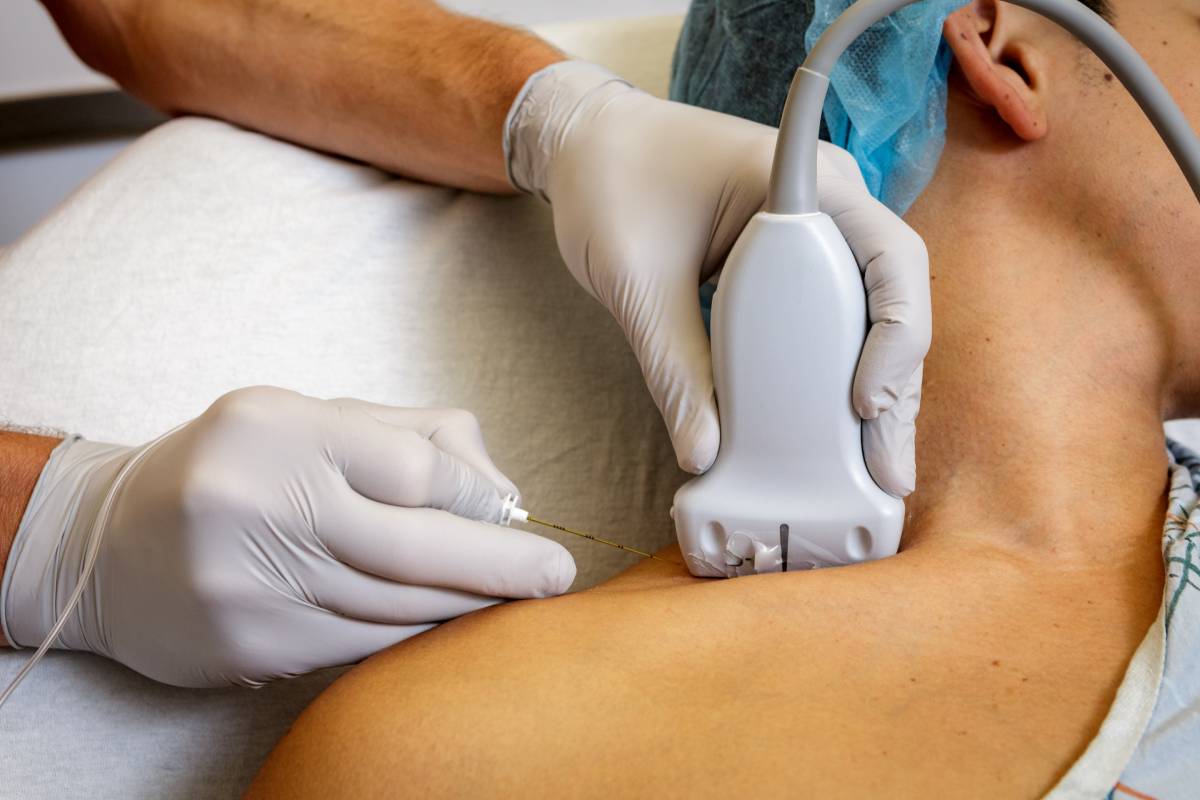Inside vs. Outside the Nerve Sheath for a Nerve Block

Ultrasound-guided interscalene brachial plexus blocks are commonly used for anesthesia of the shoulder and proximal upper arm. However, randomized controlled trials have not yet established the ideal tissue plane for needle tip placement during these nerve blocks (1). Some studies recommend placing the needle tip outside of the nerve sheath of the brachial plexus for the optimal nerve block, while others recommend placing the needle within the sheath (2). Recent articles highlight the need to establish precise and reproducible injection targets under ultrasound guidance. In a study published in the Journal of Ultrasound in Medicine, Maga et al. investigated whether injection of local anesthetic inside the nerve sheath is superior to injection outside the sheath for interscalene block (1).
This prospective, randomized study involved 60 patients undergoing elective shoulder surgery. Patients were randomly assigned to receive local anesthetic injections either inside the brachial plexus sheath or outside. In the outside group, 15 mL of ropivacaine 0.5% was injected on either side of the brachial plexus (total volume, 30 mL). In the inside group, the needle was advanced in plane from lateral to medial, through the prevertebral fascia and middle scalene muscle, until the tip was in contact with the lateral border of the brachial plexus at its interface with the middle scalene muscle (3). Pre-block and post-block vital signs were recorded, and a blinded investigator assessed motor and sensory block prior to surgery. Block success was defined as complete loss of sensation in the axillary nerve territory and inability to abduct the arm from a neutral position. Secondary outcomes included the time of onset for a successful block, incidence of transient paresthesia during needling, incidence of neural swelling, postoperative pain scores, number of required needle passes, and duration of neural blockade. All blocks were placed preoperatively for postoperative pain management and not for surgical anesthesia. General anesthesia induction was performed with propofol, fentanyl, and rocuronium. Maintenance was via inhaled sevoflurane or desflurane. Patients self-reported block duration and related complications during a follow-up telephone interview at 24 hours after surgery (1).
It was found that the rate of complete motor and sensory blocks of the axillary nerve territory 10 minutes after local anesthetic injection for the inside group was 70% versus 37% for the outside group (P < 0.05). Interestingly, at all evaluation points beyond 10 minutes, there was no statistically significant difference in complete sensory blockade whether the block was administered inside or outside the nerve sheath. The mean block onset time, however, was significantly different between study groups (3.4 minutes faster for the inside group; P < 0.05). The blocks were well tolerated by both groups. The incidence rates of transient paresthesia during needle advancement were 6.7% for the outside group and 96.7% for the inside group (P < 0.05). Sonographic neural swelling on a transverse view of the brachial plexus was not observed in any patient, nor was vascular puncture during intermittent aspiration or contralateral sensory blockade suggesting epidural spread. No permanent adverse events or prolonged neurologic deficits were reported by any patient at follow-up, and intraoperative fentanyl requirements were similar between groups and not statistically significant. The mean postoperative pain scores in the postanesthesia care unit immediately after surgery were 2/10 for the inside group and 3/10 for the outside group (P> 0.05).
In conclusion, except for faster onset, this prospective randomized trial did not find any advantages to performing an interscalene block inside the brachial plexus sheath. Additionally, there was a higher incidence of transient paresthesia when block injections were performed inside compared to outside the nerve sheath (1).
References
- Maga J, Missair A, Visan A, et al. Comparison of Outside Versus Inside Brachial Plexus Sheath Injection for Ultrasound-Guided Interscalene Nerve Blocks. J Ultrasound Med. 2016;35(2):279-285. doi:10.7863/ultra.15.01059
- Choquet O, Morau D, Biboulet P, Capdevila X. Where should the tip of the needle be located in ultrasound-guided peripheral nerve blocks?. Curr Opin Anaesthesiol. 2012;25(5):596-602. doi:10.1097/ACO.0b013e328356bb40
- Weller RS. Intraneural Injection in Regional Anesthesia: What Does the Literature Tell Us? Current Anesthesiology Reports. 2013;3(4):236-241. doi:10.1007/s40140-013-0028-3
